Scroll down
0

0





Scroll down

Burma hosts a myriad of ethnic groups. Some of these, such as the Burmese majority or the Arakan, Mon and Shan minorities, have throughout history constituted their own kingdoms.
The country is at the crossroads between the two giants that are China and India and two of its fellow members of the Association of Southeast Asian Nations (ASEAN), Laos and Thailand.
Burma is the largest and, in terms of natural resources, richest country in continental Southeast Asia. It has long been one of the poorest countries in the world.

General Aung San with women of the Kachin ethnic group before the historic meeting of Panglong in 1946 © Wikimedia Commons
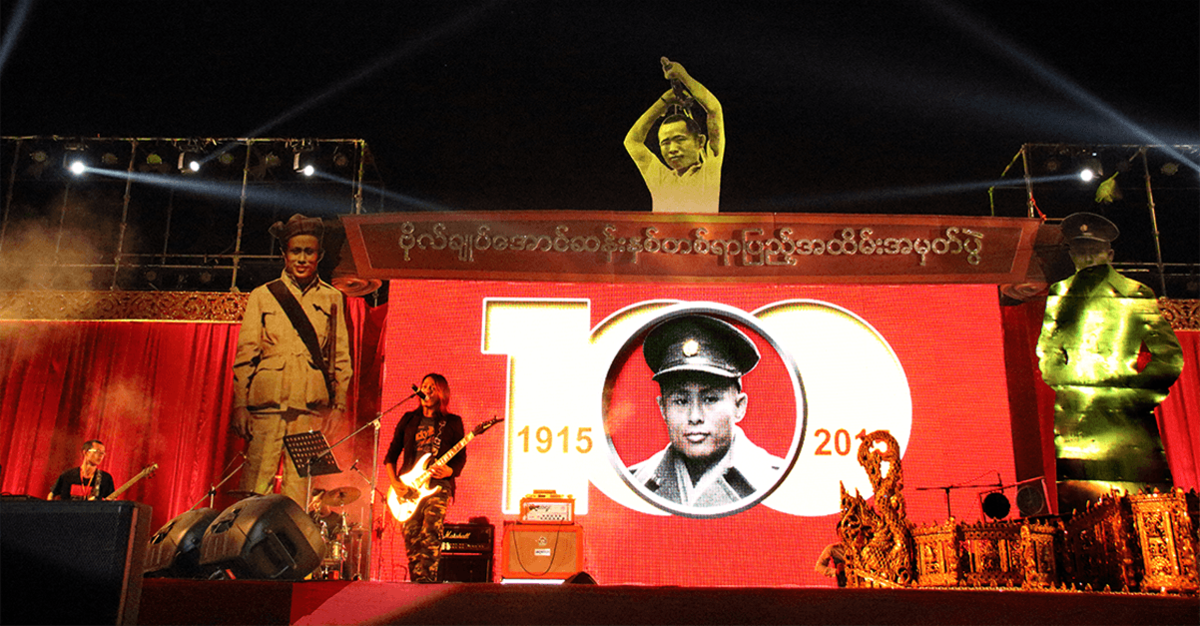
The official birthday party on the 100th anniversary of the birth of Aung San at the People's Park in the center of Yangon
To mark the 100th anniversary of his birth in 2015, a large ceremony was organized in Yangon.
Aung San remains the national hero, respected and honored by a very large majority of the country's inhabitants, whether Burmese or from other ethnic groups.

General Aung San, who was of Burmese origin, led the country after the Second World War.
On the one hand, he negotiated independence with the British, and on the other he sought to bring together the different ethnic groups present in the territory in order to build the country.

General Aung San, head of the First Burma Army in 1947 © Picture Post / Hulton Archive / Getty Images
Chronology of Burma
Chronology of Burma


Aung San Suu Kyi in the countryside in her constituency in Kyawmu, about ten kilometers from Yangon, in 2015
© Wikimedia Commons - Htoo Tay Zar

During her first year in charge, her approach to interethnic and interfaith peace has not been radically different from that of her predecessors.
While she has attracted much criticism abroad as a result of this, in her own country many people are prepared to allow her more time to make her mark.
Aung San Suu Kyi’s role has changed from that of an international icon of democracy to that of a pragmatic politician.
Aung San Suu Kyi in 2016 © Wikimedia Commons
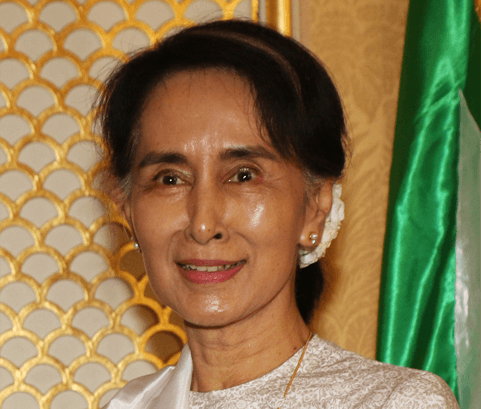

The 2015 elections
The 2015 elections
Awarded the Nobel Peace Prize in 1991, Aung San Suu Kyi is the daughter of General Aung San.
Since April 2016, after her party, the National League for Democracy, won the national elections at the end of 2015, she has been running the country's first civilian government for 55 years.
In 1991, the husband and two sons of Aung San Suu Kyi received the Nobel Peace Prize on her behalf because she was imprisoned. © Sipa Press / Rex Features
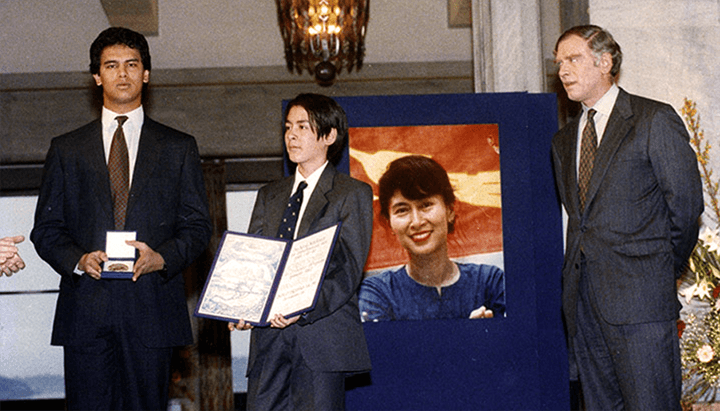
After a childhood in Yangon, Aung San Suu Kyi was educated and then lived abroad, following her diplomat mother. She continued her studies in England, where she married an English university professor with whom she had two children.
In 1988, Aung San Suu Kyi returned to Myanmar to visit her sick mother.
At the same time, a first spontaneous student revolt took place following the murder of a student by a police officer. In response to the 26 years of General Ne Win's dictatorship and a catastrophic economic situation, monks and then the wider population joined the protest, which turned into a general demand for greater freedom.
Soon, Aung San Suu Kyi joined the movement.
She became an icon, advancing before an armed soldier with a flower in her hand.
But the repression of the movement was bloody and several hundred opponents were imprisoned.
Aung San Suu Kyi was a political prisoner and subsequently spent 15 years under house arrest.
Aung San Suu Kyi as a baby with family © Wikimedia Commons


Aung San Suu Kyi as a child © Wikimedia Commons

In August 1988, Aung San Suu Kyi made a speech at a rally for the new party, the National League for Democracy


Aung San Suu Kyi was released in 2010, when the junta began moving towards a "disciplined" democratization.
The former number two of the junta, General Thein Sein, put on civilian clothes to rule the country under the new constitution of 2008.
Aung San Suu Kyi addresses the public in front of the portal of her home when she was released from house arrest in 2010.
She is with Htin Kyaw, a close friend, now President

Speech by Aung San Suu Kyi
Speech by Aung San Suu Kyi

Meeting of the National League for Democracy in the town of Pyi Oo Lwin during the campaign for the by-elections in April 2012
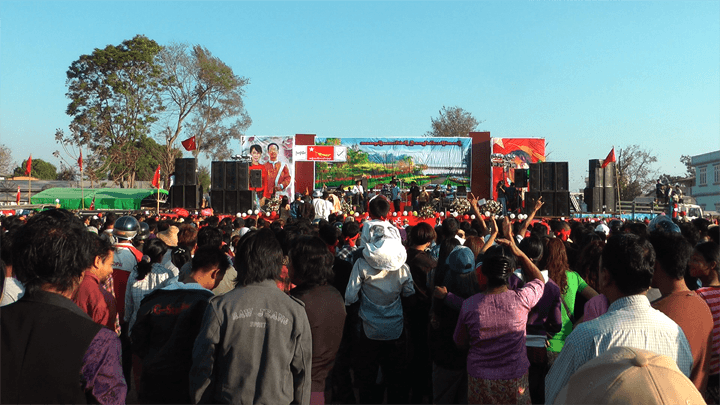
In 2012, after a boycott lasting 25 years, Aung San Suu Kyi's party, the National League for Democracy, decided to participate in by-elections.
NLD members, including Aung San Suu Kyi, were elected to 43 of the total 44 seats.
In the first two years, the decisions of his government, such as the release of political prisoners, freedom of expression and liberalization of the economy, benefited the population. The United Nations relaxed its pressure on the country.
Having remained virtually the same over several decades, Burmese society now underwent rapid change.
The ex-general Thein Sein, former number two of the military junta and president of the country between 2010 and 2015














Mya Nandar is 26 years old.
In 2008, she created an organization calle
the New Myanmar Foundation (NMF).
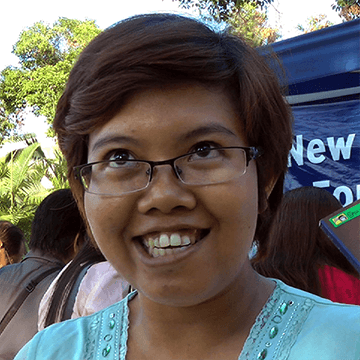



Zarni is 44 years old.
In 2010, he created the Democratic Movement of Current Forces (MDCF) with the younger generation of activists.




Nini is 45 years old.
In 2010, with a partner, Wayan, she created an organization called Share Mercy.

Everyone, with a variety of methods and agendas, is working with the population and the authorities to achieve progress on rights, especially those of the most vulnerable.

A house destroyed by the passage of Cyclone Nargis in the region of Irrawaddy.
It caused over 130,000 deaths and left hundreds of thousands of people homeless
© Wikimedia Commons

In 2008, Cyclone Nargis caused more than 130,000 deaths and made hundreds of thousands of people homeless.
The authorities’ failure to respond, and their refusal to allow fellow citizens help disaster victims (to the point of imprisoning them), did not prevent the creation of multiple and sometimes clandestine citizen networks and associations.
Civil society has created a base that has invested in the process of democratization, in parallel with the parties opposed to the junta, which have received authorization to engage in political activities anew.
Highly active, it is now one of the major levers for accomplishing the huge task necessary to reform the country’s economy and institutions.
The palms of the city of Yangon during the passage of Cyclone Nargis
© Wikimedia Commons
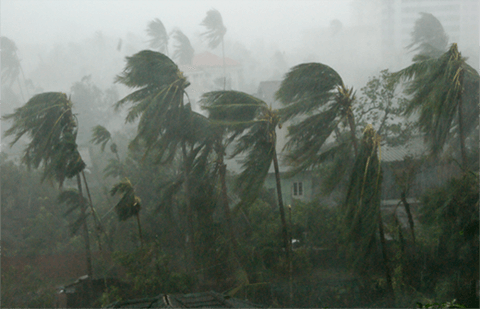



Peaceful march led by the Buddhist monastic family in Yangon during the 2007 popular uprising
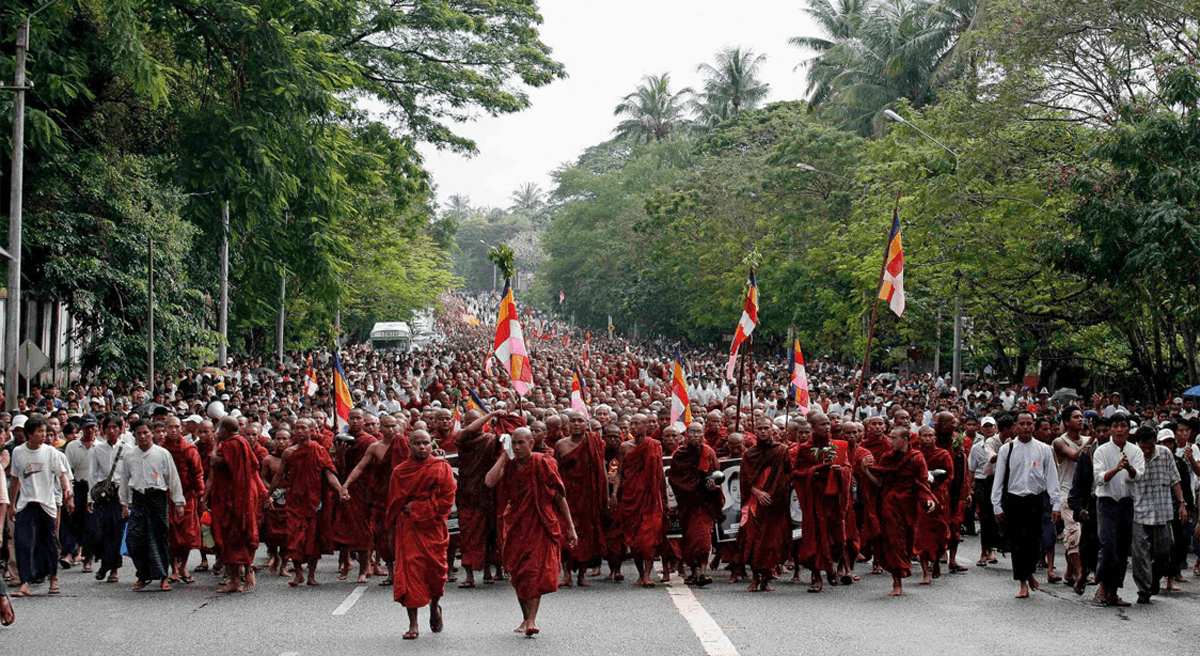
A section of the Burmese population had already begun to act, not by confronting the junta directly as during the Safran Revolution of 2007 (which was violently suppressed), but through involvement in social issues.
In her speech, Aung San Suu Kyi said that the involvement of every citizen is vital in a context where, until recently, the population could not discuss politics in public owing to official repression.

The land at the heart of national reconciliation
The land at the heart of national reconciliation
The military has been running the state for 50 years. Eighty per cent of state services are administered by former career soldiers and the Minister of the Interior is directly appointed by the Chief of the Armed Forces.
With their accomplices in business, the military controls all the wealth of the country.
Corruption remains endemic and the population suffers every day from the consequences of random justice.
The establishment
of the rule of law
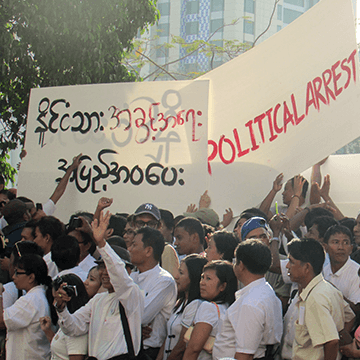
For the interest of a small number
For the interest of a small number
The most recent dates from 2008 and was written by and for the military.
It grants 25% of seats in all parliaments (national and regional) to military personnel and three ministers are appointed by the Chief of the Armed Forces.
Today, even the elected government of the NLD cannot change this constitution. This requires the approval of more than 75% of the votes. The army therefore has a de facto veto over any constitutional change.
A change
in the constitution
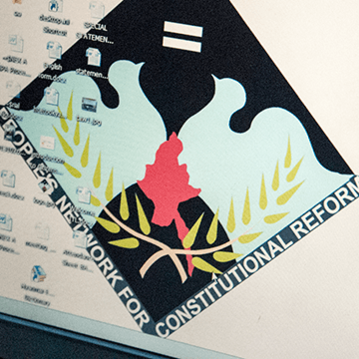
Those Buddhists that exclude
Those Buddhists that exclude
Ninety per cent of the Burmese population are Buddhist and there are tensions with the Christian, Hindu and Muslim minorities.
Over the last five years, tensions with the Muslim community have intensified, especially with an ethnic minority in Arakan, in the north-west of the country: the Rohingyas.
At the end of 2016, what appeared to be the ethnic cleansing of this minority by the police and the army was underway.
Then interfaith Peace

A powder keg of ethnic diversity
A powder keg of ethnic diversity
Inter-ethnic first to stop 60 years of civil war.
From the outbreak of the Second World War, ethnic groups rebelled against the central Burmese government.
The geographical division of the country, between the central Burmese and the peripheral regions of the minorities, continues until today.
Initiated by the previous government, there has been little progress in the peace process since the arrival of the NLD government.
Peace in the whole country!
